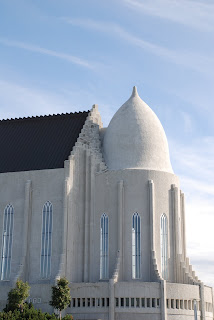Our host was generous enough to let us have breakfast right when we arrived. Fish for breakfast is still strange to me, but the salmon was delicious and impossible to pass up. It's smoked, and very thinly sliced, and it's excellent with cheese and a nice cracker. After breakfast, we headed out into town. The Hallgrimskirkja, Reykjavik's enormous Lutheran cathedral, was just a block away, so it was our first stop.


I wasn't terribly impressed with it, but Todd liked it. (Which, when it comes to architecture is almost always the case, actually.) I'm used to the Catholic cathedrals of France and Ireland with lots of decoration. This, being Lutheran (and built in the 20th century), was, shall we say, a bit light on interior decoration.
In front of the cathedral is a large statue of Leif Ericsson. Somewhat surprisingly, the statue was donated to Reykjavik by the United States, in recognition of Ericsson being the first European to land in America. Which I find odd, since we don't actually teach that to our students. I guess the Italians have a better PR team than Icelanders do. The church is on top of a hill, so we had a great view of the town and the surrounding area. The main part of town was just down the hill.

Some time later, after wandering around in town, we came across an odd sort of protest. Not being able to read Icelandic, I have no idea what was going on, but the protesters seemed inclined to draw as many sea gulls to this small building as they could. They even had slices of bread stuck under the windshield wipers of the cars parked out front. (Which I would assume belonged to people that worked there, and thus were fair targets.)

We spent a good bit of the day simply walking around the city. It's a pretty small town, really. The whole "metro" area only has about 200,000 people. Which is actually pretty impressive, considering that only just over another 100,000 live on the entire rest of the island. Anyway, it's a great city for walking. The streets are cobbled and are most definitely not laid out on a grid. Anyone who likes to joke about the streets in St Paul should go to Reykjavik sometime. As the streets wound around each other, you would catch a glimpse of a house placed back in a corner.
In the center of town there is a large park with a pond. We walked down to the park, passing the city hall building on the way, which was very interesting. The back side of the building had a fountain and the water went all the way up to the wall of the building. The weather was nice, and we were both pretty tired, so we sat on a bench in the park for a while, watching a couple kids race around on bikes.


From the park, we ended up walking along a large road and across a bridge. We were hoping to go to the Pearl, a large building up on the hill with an excellent view and a Viking wax museum. But we ended up deciding we didn't really have time for that and a puffin tour, so we just walked over to the Nordic House. We didn't know what the Nordic House was (it's a cultural center, with rotating exhibits and a goal to foster the arts and relations between the Nordic countries), but it was a very interesting looking building, and there was a nice walk through some grasslands. Next to the building, there is a sort of water project - various experiments and areas focusing on water. Especially hard to describe since I never really figured it out myself.


One of the things I really wanted to see on the trip was a puffin, so we headed from the Nordic House down to the harbor to catch a puffin tour. (Similar to whale tours, only a bit less majestic.) The walk to the harbor was scenic in itself.


It was really the end of the season for the small birds, but the tour guide was still running trips. And I figured I didn't really need to see thousands of them. Even just one would suit me fine. And, even if we hadn't seen a single puffin, the boat ride would have been worth it.


We did actually see several puffins. I'm not posting pictures of them, because I was more concerned with looking at them than taking pictures, so the handful I do have really just look like a small black bird with a lot of water.
After the puffin tour, we were getting pretty beat. We found a nice little place for dinner that wasn't too outrageous. (At least in comparison with the food in general, which is all outrageously expensive.) The food was spectacular and would have been worth even more than what we paid for it. Pickled herring with apples and beets for an appetizer, and a fish gratin with all sorts of different fish (and lobster!). After that, it was essentially home to bed. We had both been up for about 36 hours, and we had to be up around 5 to catch a bus back to the airport.




















































